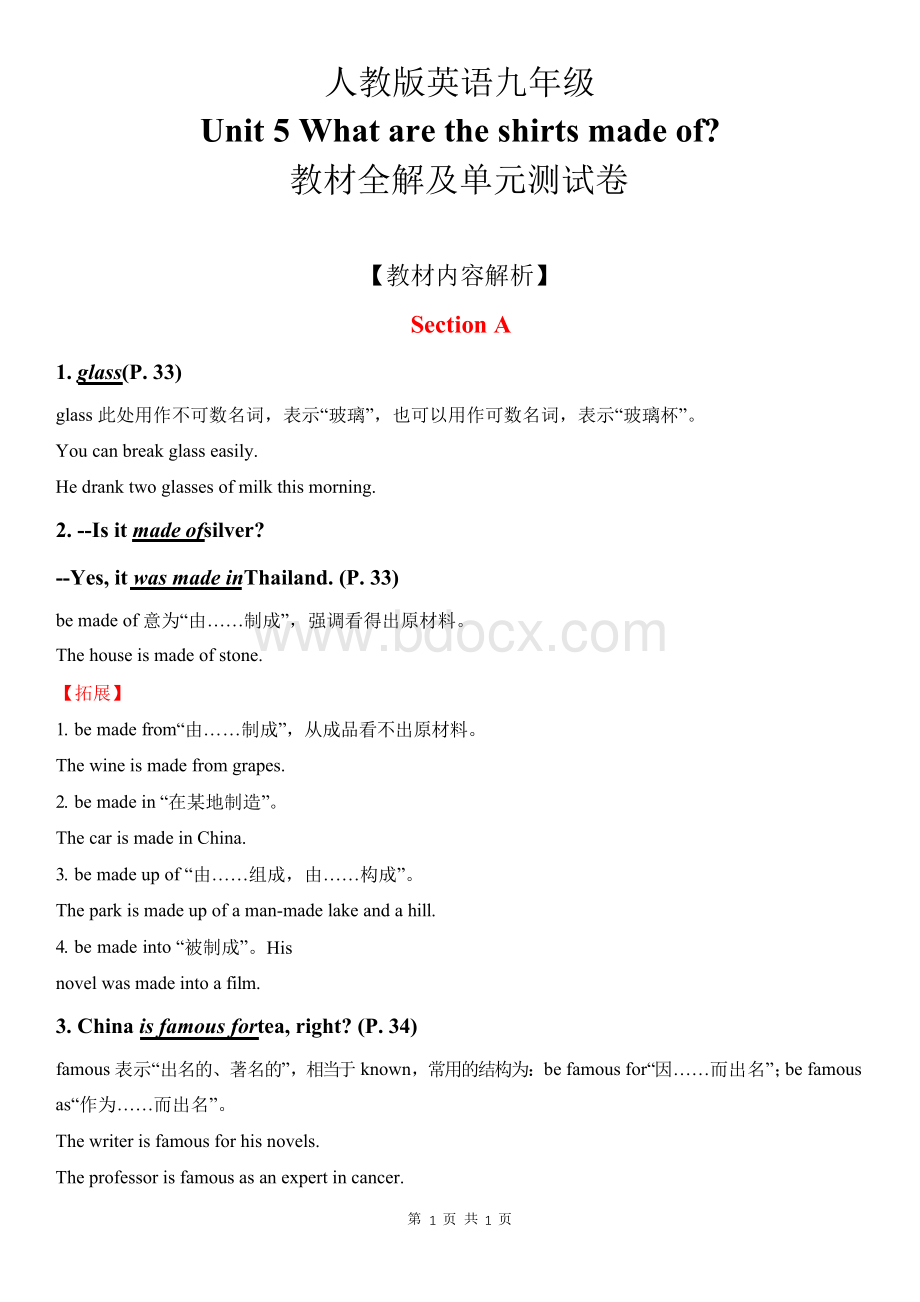人教版英语九年级Unit 5 What are the shirts made of 教材全解及单元测试卷Word格式.docx
《人教版英语九年级Unit 5 What are the shirts made of 教材全解及单元测试卷Word格式.docx》由会员分享,可在线阅读,更多相关《人教版英语九年级Unit 5 What are the shirts made of 教材全解及单元测试卷Word格式.docx(22页珍藏版)》请在冰豆网上搜索。

Thehouseismadeofstone.
【拓展】
1.bemadefrom“由……制成”,从成品看不出原材料。
Thewineismadefromgrapes.
2.bemadein“在某地制造”。
ThecarismadeinChina.
3.bemadeupof“由……组成,由……构成”。
Theparkismadeupofaman-madelakeandahill.
4.bemadeinto“被制成”。
Hisnovelwasmadeintoafilm.
3.Chinaisfamousfortea,right?
(P.34)
famous表示“出名的、著名的”,相当于known,常用的结构为:
befamousfor“因……而出名”;
befamous
as“作为……而出名”。
Thewriterisfamousforhisnovels.
Theprofessorisfamousasanexpertincancer.
第
1页 1页
共
4.WhereisteaproducedinChina?
produce此处用作及物动词,表示“生产、制造”。
Thegreenplantsproduceoxygen.
5.Forexample,AnxiandHangzhouarewidelyknownfortheirtea.(P.34)
(1)widely用作副词,表示“广泛地、普遍地”。
Themedicineiswidelyusednow.
(2)beknownfor意为“以……而闻名”,相当于befamousfor。
JayChouisfamousforhissongs.
6.Well,asfarasIknow,teaplantsaregrownonthesidesofmountains.(P.34)
asfarasIknow意为“就我所知”,相当于asfarasIamconcerned。
AsfarasIknow,hehasbeenabroad.
7.Whentheleavesareready,theyarepickedbyhandandthenaresentforprocessing.
(P.34)
byhand意为“用手、手工”。
Thekiteismadebyhand.
8.ItseemsthatmanypeopleallovertheworlddrinkChinesetea.(P.34)
(1)seem用作系动词,表示“似乎、好像”,常用的结构有:
seem+adj./tobe/that+句子。
Thestoryseemstrue.
Whathesaidseemedtobealie.
Itseemsthattheyaregoingtopulldownthehouse.
(2)allovertheworld意为“全世界、世界各地”。
Wehavefriendsallovertheworld.
9....peoplesaythatteaisgoodforbothhealthandbusiness!
both...and...意为“两者都”,并列两个主语时,谓语动词用复数形式,反义短语为neither...nor...“既不……
也不……”。
BothTomandJimareinterestedinMath.
10.Nomatterwhatyoumaybuy,youmightthinkthoseproductsweremadeinthosecountries.(P.35)
nomatter意为“无论、不论”,后接特殊疑问词,引导让步状语从句。
2页 2页
Nomatterwhatyousay,Iwon’tbelieveyou.Nomatterwhoyouare,youmustobeytherules.
11.HefounditinterestingthatsomanyproductsinthelocalshopweremadeinChina.
(P.35)
有些动词后面接复合宾语时,常用it作形式宾语,而真正的宾语则由动词不定式来担当,并位于宾语补足语之后。
常见的这样的动词有find,think,feel,make等。
Ifinditinterestingtoplaycomputergames我发现玩电脑游戏很有趣。
Weallthinkitverydifficulttofinishtheworkinanhour.
12.ToysarenottheonlythingsmadeinChina.(P.35)madeinChina作后置定语修饰theonlythings,表示被动关系。
IborrowedabookwrittenbyMarkTwainfromthelibrary.
13.HerealizedthatAmericanscanhardlyavoidbuyingproductsmadeinChina.(P.35)
avoid表示“避免”,后常接名词或者动名词作宾语。
Youshouldcheckyourpaperagainandagaintoavoidsillymistakes.Hechosethatwaytotheschoolandavoidedmeetinghisteacher.
14.KangJianthinksit’sgreatthatChinaissogoodatmakingtheseeverydaythings.(P.
35)
everyday是形容词,意为“日常的”只作定语;
everyday是副词短语,在句中作时间状语。
TheInternethadbecomeapartofeverydaylife.Weshouldtakeexerciseeveryday.
15.Childrenunder18arenotallowedtowatchthisshowwithouttheirparents.(P.35)
①allowdoingsth.允许做某事
Theshopkeeperdoesn’tallowsmokinginanycorneroftheshop.
②allowsb.todosth.允许某人做某事
Hisparentsallowhimtoplaycomputergamesifhefinisheshishomework.
16.WearepaidbythebossonthelastFridayofeachmonth.(P.36)
spend
pay
主语是人
spend...onsth./spend...(in)doingsth.
payforsth./paysb.forsth.
辨析spend,pay,take和cost
3页 3页
take
cost
主语是it
主语是物
Ittakessb.+时间+todosth.
sth.costssb.+金钱
17.Mostofthesurfaceiscoveredbywater.(P.36)
cover表示“覆盖”时,常用的结构为:
cover...with...“用……覆盖……”。
被动结构为:
becoveredwith
sth.“被……覆盖”。
Themothercoveredherdaughterwithablanketatnight.Thegroundwasusuallycoveredwithsnowinwinter.
SectionB
1.sawmanydifferentkindsofkitesatthefestival.(P.37)
differentkindsof“不同种类的”,allkindsof表示“各种各样的”,akindof“一种”。
Childrentakepartinallkindsofactivitiesinschool.
2.wanttolearntoflyakite.(P.37)
learn用作及物动词,表示“学习”,后常接名词、代词或者动词不定式作宾语。
Heislearningasecondforeignlanguage.Childrenshouldlearntowalkbythemselves.
3.TheinternationalkitefestivalsisheldinAprileveryyear.(P.37)
hold此处用作及物动词,意为“举办、举行”。
Theywillholdameetingtodiscussthisproblemtomorrow.
4.Thecompetitorsatthefestivalarefromallovertheworld.(P.37)
competitor意为“参赛者、竞争者”,是由动词compete“竞争”变化而来的,competition表示“竞争、比赛”。
Whowillyoucompetewith?
Whowonthecompetition?
5.EachdifferentpartofChinahasitsownspecialformsoftraditionalart.(P.38)
(1)own用作形容词,表示“自己的”,常用于短语:
ofone’sown意为“属于某人自己的”,oneone’sown“独自地、单独地”。
Thismanhasahouseofhisown.Hebuiltitonhisownlastyear.
(2)form此处用作可数名词,意为